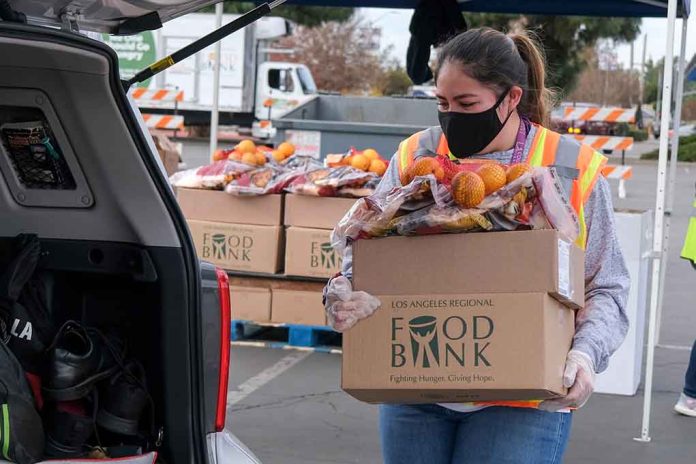
President Trump’s “MAHA food boxes” aim to deliver fresh produce directly from American farmers to seniors, replacing the traditional food bank system that many elderly Americans have relied on for years.
Key Takeaways
- Trump’s budget proposes replacing the Commodity Supplemental Food Program (CSFP) with “MAHA food boxes” sourced directly from farmers to seniors.
- The initiative, led by HHS Secretary Robert F. Kennedy Jr., aims to provide healthier food options while supporting American agriculture.
- Critics worry about logistical challenges of delivering perishable foods to 730,000 seniors currently served by the CSFP.
- The USDA claims the new program would offer more nutritious foods while reducing administrative costs.
- The proposed change comes amid a broader 23% cut in non-defense spending, including a $5 billion reduction in USDA programs.
MAHA Initiative: A Fresh Approach to Senior Nutrition
The Trump administration has unveiled plans to transform how America’s low-income seniors receive food assistance. The proposed budget would replace the current Commodity Supplemental Food Program (CSFP), which serves approximately 730,000 seniors through food banks, with “MAHA food boxes” inspired by Health and Human Services Secretary Robert F. Kennedy Jr.’s Make America Healthy Again initiative. The new program would deliver fresh produce directly from American farmers to elderly recipients, bypassing traditional distribution channels in an effort to improve nutritional quality and support domestic agriculture.
“The funds will allow Kennedy to ‘tackle nutrition, physical activity, healthy lifestyles, over-reliance on medication and treatments, the effects of new technological habits, environmental impacts, and food and drug quality and safety’ across the agency,” said Health and Human Services Secretary Robert F. Kennedy Jr.
With $500 million allocated to Kennedy’s MAHA Commission, the administration aims to address chronic disease rates in children by examining factors like diet and environmental influences. The MAHA food box program represents a significant shift in how nutritional assistance is delivered to seniors, focusing on direct farm-to-recipient distribution that eliminates intermediaries while potentially promoting healthier eating habits among recipients.
Budget Cuts and Program Restructuring
The MAHA food box initiative is part of a broader budget restructuring that includes nearly 23% cuts in non-defense spending for fiscal year 2026. USDA programs face a substantial $5 billion reduction, impacting various sectors from agricultural research to rural development. The budget eliminates programs deemed “wasteful” or “woke,” including those focused on climate change and diversity initiatives that were priorities under the previous administration.
“The budget eliminates wasteful, woke programming in NIFA, such as activities related to climate change, renewable energy, and promoting DEI in education that were prioritized under the Biden Administration,” states the budget summary.
International food aid programs face elimination, including Food for Peace and McGovern-Dole programs, saving over $1.8 billion. Rural Development programs would see a $721 million cut, with the focus shifting to “programs that have demonstrated efficient results.” The administration aims to prioritize infrastructure loans for aging rural water and wastewater systems, while community facility grants and new broadband funding would be eliminated.
Concerns and Criticisms
Despite the administration’s optimistic outlook on the MAHA food box program, critics have raised concerns about its implementation and impact on seniors. The logistics of delivering perishable foods directly to elderly recipients presents challenges that the current food bank system doesn’t face. Additionally, some worry that fresh produce alone may not provide the complete nutritional support that seniors currently receive through the CSFP, which includes non-perishable items essential for those with limited cooking abilities or storage options.
“What we do know is that the program that we currently have is working, and seniors have come to rely on us. We have no details [about logistics of the MAHA food boxes], and this has been a continued challenge that we’ve had with this administration, where decisions are sort of made overnight,” said George Matysik.
The USDA defends the proposal, stating that MAHA boxes would offer more wholesome foods while reducing administrative costs. The agency has suggested the program could eventually expand beyond senior assistance to “either supplant or complement current USDA programs.” This aligns with Kennedy’s broader push to promote natural foods and alternative medicines, as well as the administration’s commitment to supporting American farmers and reducing dependence on processed foods.
Looking Forward: Impact on America’s Seniors
As the budget proposal moves forward, advocates for senior nutrition are watching closely. The CSFP currently operates with a $389 million budget, a fraction of the $100 billion spent on SNAP for 41 million Americans. While the administration frames the MAHA food box program as an improvement that will provide healthier options, there are significant questions about implementation timelines, delivery infrastructure, and whether the new program will adequately serve all 730,000 seniors currently receiving assistance.
“Our seniors in particular are already hurting. We’re hearing about cuts to the SNAP program. We’re seeing about cuts to Medicaid and Medicare. We’re really worried about our senior citizens in this funding environment from our federal government right now,” said George Matysik.
The success of the MAHA food box program will likely depend on how effectively it addresses these concerns while delivering on its promise of fresher, healthier food options for America’s vulnerable senior population. The administration’s commitment to cutting “wasteful” spending while improving nutritional outcomes will be tested as the details of implementation become clearer in the coming months.



